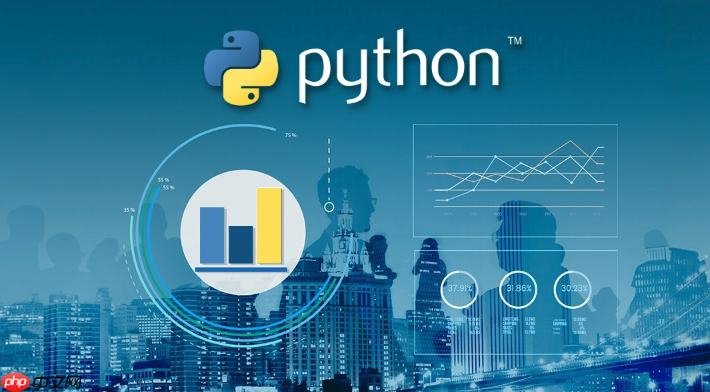答案:可通过键盘中断、信号处理、多线程、asyncio等方式中断Python脚本,结合try-finally、with语句或atexit模块实现资源清理,使用标志变量或调试工具设置中断点,通过systemd、supervisor或监控脚本实现自动重启。

运行Python脚本时,可以使用一些方法来暂停或中断脚本的执行。最常用的方法是使用键盘中断(通常是
Ctrl+C
解决方案
键盘中断 (Ctrl+C): 这是最直接的方法。当你在终端运行脚本时,按下
Ctrl+C
KeyboardInterrupt
import time
try:
while True:
print("脚本正在运行...")
time.sleep(1) # 模拟一些工作
except KeyboardInterrupt:
print("\n用户中断,正在清理...")
# 在这里添加你的清理代码
print("清理完成,程序退出。")这种方法简单粗暴,但不够优雅,尤其是在脚本需要处理文件、网络连接等资源时。
立即学习“Python免费学习笔记(深入)”;
使用信号 (signal):
signal
SIGINT
Ctrl+C
import signal
import time
import sys
running = True
def signal_handler(sig, frame):
global running
print('你按下了 Ctrl+C!')
running = False
signal.signal(signal.SIGINT, signal_handler)
print('按下 Ctrl+C 来停止')
while running:
print("脚本正在运行...")
time.sleep(1)
print("程序退出。")这种方法比直接捕获
KeyboardInterrupt
使用多线程 (threading): 将耗时操作放在一个单独的线程中,主线程负责监听用户的输入或其他的停止信号。
import threading
import time
def worker():
while True:
print("工作线程正在运行...")
time.sleep(1)
def main():
worker_thread = threading.Thread(target=worker)
worker_thread.daemon = True # 设置为守护线程,主线程退出时自动退出
worker_thread.start()
try:
while True:
time.sleep(0.1) # 避免CPU占用过高
except KeyboardInterrupt:
print("\n主线程中断,正在等待工作线程退出...")
# 这里可以添加一些清理代码,或者直接让程序退出
print("程序退出。")
if __name__ == "__main__":
main()使用线程可以让你在不阻塞主线程的情况下执行耗时操作,并且更容易控制程序的停止。注意线程安全问题,避免在多个线程中同时访问共享资源。
使用asyncio
asyncio
import asyncio
async def worker():
while True:
print("异步任务正在运行...")
await asyncio.sleep(1)
async def main():
task = asyncio.create_task(worker())
try:
await asyncio.sleep(10) # 运行10秒
except asyncio.CancelledError:
print("异步任务被取消。")
finally:
task.cancel()
await task # 等待任务完成取消
if __name__ == "__main__":
asyncio.run(main())asyncio
资源清理是脚本中断时最重要的任务之一。如果你的脚本打开了文件、建立了网络连接、或者使用了数据库连接,必须确保在退出前正确地关闭它们。
使用 try...finally
finally
f = None
try:
f = open("my_file.txt", "w")
f.write("一些数据")
except IOError:
print("发生IO错误")
finally:
if f:
f.close()
print("文件已关闭。")使用 with
with
with
with open("my_file.txt", "w") as f:
f.write("一些数据")
# 文件在这里自动关闭
print("文件已关闭。")注册 atexit
atexit
import atexit
def cleanup():
print("执行清理操作...")
atexit.register(cleanup)
print("程序正在运行...")atexit

AutoIt v3 版本, 这是一个使用类似 BASIC 脚本语言的免费软件, 它设计用于 Windows GUI(图形用户界面)中进行自动化操作. 利用模拟键盘按键, 鼠标移动和窗口/控件的组合来实现自动化任务. 而这是其它语言不可能做到或无可靠方法实现的(比如VBScript和SendKeys). AutoIt 非常小巧, 完全运行在所有windows操作系统上.(thesnow注:现在已经不再支持win 9x,微软连XP都能放弃, 何况一个win 9x支持), 并且不需要任何运行库. AutoIt
 57
57

有时候,你可能希望在脚本的特定位置设置中断点,而不是依赖于外部信号。这对于调试或者在生产环境中进行监控非常有用。
使用标志变量: 在脚本中定义一个标志变量,并在循环中定期检查它的值。如果标志变量被设置为
False
import time
stop_flag = False
def set_stop_flag():
global stop_flag
stop_flag = True
while not stop_flag:
print("脚本正在运行...")
time.sleep(1)
print("脚本已停止。")你可以通过其他方式(例如,从文件中读取、通过网络接收信号)来设置
stop_flag
使用条件断点 (pdb): Python 的调试器
pdb
import pdb
import time
i = 0
while True:
i += 1
print(f"i = {i}")
pdb.set_trace() # 每次循环都进入调试器
time.sleep(1)在
pdb
c
b 10, i > 10
i
使用日志记录和监控: 在脚本中添加详细的日志记录,并使用监控工具来观察脚本的运行状态。如果发现异常情况,可以通过外部手段(例如,发送信号、修改配置文件)来中断脚本的执行。
对于一些关键的、需要长时间运行的脚本,你可能希望在脚本意外中断后自动重启它。
使用 systemd
systemd
systemd
创建一个名为
my_script.service
[Unit] Description=My Python Script After=network.target [Service] User=your_user WorkingDirectory=/path/to/your/script ExecStart=/usr/bin/python3 my_script.py Restart=on-failure RestartSec=5 [Install] WantedBy=multi-user.target
将
your_user
/path/to/your/script
my_script.py
/etc/systemd/system/
sudo systemctl daemon-reload sudo systemctl enable my_script.service sudo systemctl start my_script.service
Restart=on-failure
RestartSec=5
使用 supervisor
supervisor
pip
pip install supervisor
编写一个简单的监控脚本: 你可以编写一个简单的 Python 脚本,用来监控目标脚本的运行状态。如果目标脚本退出,则自动重启它。
import subprocess
import time
def run_script():
while True:
try:
process = subprocess.Popen(["python3", "my_script.py"])
process.wait()
print("脚本已退出,正在重启...")
time.sleep(5) # 等待 5 秒
except Exception as e:
print(f"发生错误:{e}")
time.sleep(60) # 等待 60 秒,避免频繁重启
if __name__ == "__main__":
run_script()这种方法比较简单,但不够健壮,需要考虑更多的异常情况。
以上就是运行Python脚本怎样暂停执行中的脚本 运行Python脚本的中断执行实用方法的详细内容,更多请关注php中文网其它相关文章!

每个人都需要一台速度更快、更稳定的 PC。随着时间的推移,垃圾文件、旧注册表数据和不必要的后台进程会占用资源并降低性能。幸运的是,许多工具可以让 Windows 保持平稳运行。

Copyright 2014-2025 https://www.php.cn/ All Rights Reserved | php.cn | 湘ICP备2023035733号